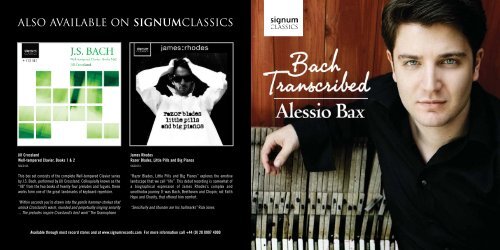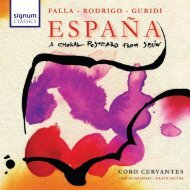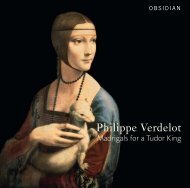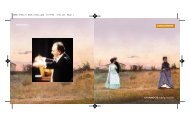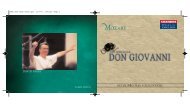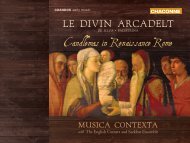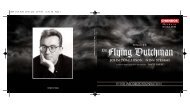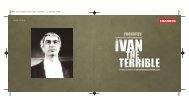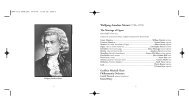ALSO AVAILABLE on SIGNUMclassics - Chandos
ALSO AVAILABLE on SIGNUMclassics - Chandos
ALSO AVAILABLE on SIGNUMclassics - Chandos
Create successful ePaper yourself
Turn your PDF publications into a flip-book with our unique Google optimized e-Paper software.
<str<strong>on</strong>g>ALSO</str<strong>on</strong>g> <str<strong>on</strong>g>AVAILABLE</str<strong>on</strong>g> <strong>on</strong> signumclassics<br />
Jill Crossland<br />
Well-tempered Clavier, Books 1 & 2<br />
SIGCD136<br />
This box set c<strong>on</strong>sists of the complete Well-tempered Clavier series<br />
by J.S. Bach, performed by Jill Crossland. Colloquially known as the<br />
“48” from the two books of twenty-four preludes and fugues, these<br />
works form <strong>on</strong>e of the great landmarks of keyboard repertoire.<br />
“Within sec<strong>on</strong>ds you’re drawn into the gentle hammer-strokes that<br />
unlock Crossland’s warm, rounded and perpetually singing s<strong>on</strong>ority<br />
... The preludes inspire Crossland’s best work” The Gramoph<strong>on</strong>e<br />
James Rhodes<br />
Razor Blades, Little Pills and Big Pianos<br />
SIGCD153<br />
“Razor Blades, Little Pills and Big Pianos” explores the emotive<br />
landscape that we call “life”. This debut recording is somewhat of<br />
a biographical expressi<strong>on</strong> of James Rhodes’s complex and<br />
unorthodox journey. It was Bach, Beethoven and Chopin; not Faith<br />
Hope and Charity, that offered him comfort.<br />
“Sensitivity and thunder are his hallmarks” Rick J<strong>on</strong>es<br />
Available through most record stores and at www.signumrecords.com For more informati<strong>on</strong> call +44 (0) 20 8997 4000
Bach Transcribed<br />
Violin S<strong>on</strong>ata No.1 in G minor<br />
L. Godowsky<br />
1. Adagio [5.07]<br />
2. Fuga [4.09]<br />
3. Siciliana [3.51]<br />
4. Presto [Finale] [3.18]<br />
5. Sheep May Safely Graze E. Petri [5.18]<br />
6. Air from the Orchestral Suite No.3 in D major A. Siloti [5.33]<br />
7. Gavotte (Tempo di Borea) from the C. Saint-Säens [3.19]<br />
Violin Partita No.1 in B minor<br />
8. Andante from the Violin S<strong>on</strong>ata No.2 in A minor A. Siloti [4.52]<br />
9. Siciliano from the Flute S<strong>on</strong>ata in Eb major A. Siloti [2.18]<br />
10. “Zi<strong>on</strong> hört die Wächter singen”, from the Cantata W. Kempff [5.17]<br />
BWV 140 “Wachet auf, ruft uns die Stimme”<br />
11. Largo from the Keyboard C<strong>on</strong>certo in F minor A. Bax [3.43]<br />
12. Bourreé from Cello Suite No.3 in C major L. Godowsky [4.30]<br />
13. Chac<strong>on</strong>ne from the Violin Partita No.2 in D minor F. Bus<strong>on</strong>i [14.28]<br />
Total Timings [65.45]<br />
Alessio Bax piano<br />
www.signumrecords.com<br />
Today it is remarkable to realise that there was a<br />
time when Bach was viewed as a respectable and<br />
learned rather than inspired composer, serious to<br />
a fault and designed for an essentially cold and<br />
academic taste. His children referred to him as<br />
‘the old wig’ and it wasn’t until the nineteenth<br />
century that awareness of his true stature (aided<br />
by Mendelssohn’s enthusiasm) occurred. Only then<br />
did musicians become c<strong>on</strong>scious of the unique<br />
depth and spiritual dimensi<strong>on</strong> of his allencompassing<br />
art, a small step towards seeing<br />
him as the true father of music. For many the 48<br />
Preludes and Fugues remain the ‘Old Testament’<br />
of music (with Beethoven’s 32 Piano S<strong>on</strong>atas<br />
following as the New). Yet there is nothing of the<br />
old in so many of Bach’s boldly experimental<br />
works, in The Art of Fugue, the Goldberg<br />
Variati<strong>on</strong>s, the Gigue from the 6 th English Suite,<br />
the Prelude and Fugue in A minor (described by<br />
Albert Schweitzer as ‘am<strong>on</strong>g the grandest things<br />
in keyboard literature’) and perhaps most of all<br />
the Prelude (fantasia) in A minor BWV 922 (to take<br />
a random selecti<strong>on</strong>). Here Bach exhibits an<br />
improvisatory freedom and daring that gives his<br />
music a timeless veracity and lends some<br />
credence to András Schiff’s belief that ‘Bach is the<br />
most romantic of all composers.’<br />
- 3 -<br />
Delius may have scorned what he saw as Bach’s<br />
restricti<strong>on</strong> and c<strong>on</strong>servatism but others, more<br />
informed and less biased, have tirelessly<br />
celebrated what they undoubtedly saw as the<br />
foundati<strong>on</strong> st<strong>on</strong>e of great music. Several pianists,<br />
too, have placed Bach at the centre of their<br />
repertoires (Glenn Gould and Rosalyn Tureck, who<br />
early in her career forsook all others to c<strong>on</strong>centrate<br />
exclusively <strong>on</strong> Bach) while many great Russian<br />
pianists (Tatiana Nikolayeva, Feinberg and<br />
Richter) rejoiced in music previously dismissed in<br />
their country as little more than useful<br />
examinati<strong>on</strong> fodder.<br />
It is therefore hardly surprising that so many<br />
composers have wished to pay pers<strong>on</strong>al and often<br />
idiosyncratic tribute to Bach, ranging across the board<br />
from Liszt, Rachmaninov and Kabalevsky to Villa-Lobos<br />
(his exotic Bachianas Brasileiras) and including a<br />
wide variety of pianists and pianist-composers.<br />
And this brings me to the questi<strong>on</strong>, when is a<br />
transcripti<strong>on</strong> a transcripti<strong>on</strong>? Liszt, to take a<br />
towering example, wrote 193 transcripti<strong>on</strong>s. And<br />
these divide into ‘partiti<strong>on</strong>s’ (objective recreati<strong>on</strong>s<br />
where the chosen work is lifted bodily from <strong>on</strong>e<br />
medium to another without undue elaborati<strong>on</strong> or<br />
alterati<strong>on</strong> of its intrinsic nature or character) and<br />
‘paraphrase’ or more particularly ‘paraphrase de
c<strong>on</strong>cert’ where the glory or triviality of the original<br />
is accentuated and c<strong>on</strong>centrated by a dizzying<br />
form of précis; the accent as much <strong>on</strong> the<br />
recreator as the creator, <strong>on</strong> the arranger as well as<br />
the composer. Altruistic if self-promoting, all<br />
great transcribers are motivated by a desire to<br />
share their love of the great and less great usually<br />
in an age when the disseminati<strong>on</strong> of music was<br />
difficult, when c<strong>on</strong>certs were often inaccessible<br />
and records n<strong>on</strong>-existent.<br />
Leopold Godowsky (1870-1938), to take the first<br />
transcriber in Alessio Bax’s recital, was a pianist<br />
of legendary prowess capable, particularly in<br />
private, of achieving ultimate feats of pianistic<br />
brilliance reflected in his Strauss Paraphrases<br />
and his 53 Studies <strong>on</strong> Chopin’s 27 Studies, a<br />
delight in taking virtuosity to new undreamed of<br />
heights. Yet even here he c<strong>on</strong>fr<strong>on</strong>ts the inevitable<br />
brickbats that came his way, the accusati<strong>on</strong> of<br />
tampering and gilding the lily or a ‘trading <strong>on</strong><br />
sacred soil’ with a show of disarming candour and<br />
modesty. He wishes <strong>on</strong>ly to ‘probe hidden<br />
beauties’ believing that Bach would not have<br />
disapproved, in view of the amazing modernisms<br />
so frequently found in his compositi<strong>on</strong>s and<br />
c<strong>on</strong>sidering his very free amendments to his own<br />
and other composer’s works. Indeed, for the<br />
ever-outrageous Kaikhosru Sorabji, Godowsky<br />
transcended Bach’s ‘dry, rattling skelet<strong>on</strong>s of<br />
compositi<strong>on</strong>s’ investing them with a grandeur and<br />
richness bey<strong>on</strong>d the originals. Alas, Godowsky<br />
would have felt slighted and insulted rather than<br />
praised by such a claim, particularly when it was<br />
his intenti<strong>on</strong> to approach with ‘awe and reverence<br />
the imperishable w<strong>on</strong>ders of Bach.’ And here, in<br />
the First Violin S<strong>on</strong>ata, Godowsky achieves an<br />
extraordinary fusi<strong>on</strong> of virtuosity and restraint.<br />
Single lines are embellished with all of his<br />
fullness and c<strong>on</strong>trapuntal skill yet the result is<br />
never less than serious. Violinists will gasp in<br />
admirati<strong>on</strong> or outrage while pianists will find<br />
themselves c<strong>on</strong>fr<strong>on</strong>ted by a mighty challenge,<br />
requiring rare agility and an acute ear for keeping<br />
so many multi-textures, layers and lines clear.<br />
Again, Eg<strong>on</strong> Petri’s transcripti<strong>on</strong> of Sheep May<br />
Safely Graze is a far cry from Harriet Cohen’s more<br />
familiar versi<strong>on</strong>. Here, Bach’s hauntingly beautiful<br />
melody is lovingly ornamented with many opalescent<br />
parts and textures.<br />
Alexander Siloti (1863-1945) was a pupil of Liszt,<br />
famous for his transcripti<strong>on</strong> of Bach’s E minor<br />
Prelude (or rather made famous by Emil Gilels who<br />
invariably offered it as a valedictory encore at the<br />
close of his recitals) and infamous for his<br />
scissors-and-paste job <strong>on</strong> Tchaikovsky’s Sec<strong>on</strong>d<br />
Piano C<strong>on</strong>certo. And his way with the Air from the<br />
Orchestra Suite No.3 in D major, the Andante<br />
from the Violin S<strong>on</strong>ata No.2 in A minor and the<br />
Siciliano from the Flute S<strong>on</strong>ata in E flat major is<br />
altogether more effortless and transparent,<br />
aiming for simplicity rather than elaborati<strong>on</strong>.<br />
Wilhelm Kempff (1885-1991), a uniquely subtle<br />
pianist with a s<strong>on</strong>ority all hiw own, also believes<br />
that Bach is best served by simplicity and, unlike<br />
his roseate and romantic transcripti<strong>on</strong> of, say,<br />
Handel’s G minor Minuet from his first<br />
Harpsichord Suite, he is memorably restrained in<br />
Zi<strong>on</strong> hört die Wächter singen and so, too, is Alessio<br />
Bax himself in his arrangement of the Largo from<br />
the F minor C<strong>on</strong>certo.<br />
Saint-Säens (1835-1921) brings a touch of French<br />
chic to Bach’s Gavotte (Tempo di Borea) from the<br />
Violin Partita No.1 in B minor, his vital and stylish<br />
transcripti<strong>on</strong> at the opposite pole to Bax’s final<br />
offering, the mighty Bach-Bus<strong>on</strong>i Chac<strong>on</strong>ne, a set<br />
of 29 variati<strong>on</strong>s <strong>on</strong> an eight bar theme taken form<br />
the D minor Partita for Solo Violin. Here, we return<br />
to virtuosity <strong>on</strong> the grandest scale and a reminder<br />
that for Bus<strong>on</strong>i (1866-1924) the piano was the<br />
true King of Instruments.<br />
It <strong>on</strong>ly remains for me to add a pers<strong>on</strong>al note. I<br />
first heard Alessio Bax as a jury member at the<br />
1997 Internati<strong>on</strong>al Hamamatsu Piano Competiti<strong>on</strong><br />
in Japan where he w<strong>on</strong> first prize, preceding this<br />
by a first prize at Ferrol in Spain and yet another<br />
first at Leeds in 2000. His performances in Japan<br />
were of an ast<strong>on</strong>ishing brilliance and acuteness<br />
and never more so than in Granados’s Amor y la<br />
muerte (No 5 from the Goyescas) which I<br />
remember as if it was yesterday. And now this<br />
richly enterprising Bach transcripti<strong>on</strong> recital can<br />
<strong>on</strong>ly enhance his already formidable internati<strong>on</strong>al<br />
standing and career.<br />
© Bryce Morris<strong>on</strong>, 2009.<br />
- 4 -<br />
- 5 -
ALESsIO BAX<br />
Winner of the prestigious Avery Fisher Career Grant for<br />
2009, Alessio Bax is praised internati<strong>on</strong>ally for his<br />
lyrical playing and insightful interpretati<strong>on</strong>s. At the<br />
age of 19 he w<strong>on</strong> the First Prize at the Hamamatsu<br />
Internati<strong>on</strong>al Piano Competiti<strong>on</strong> in Japan, and was<br />
First Prize winner in the universally acknowledged<br />
Leeds Internati<strong>on</strong>al Pianoforte Competiti<strong>on</strong> in 2000.<br />
Acclaimed by the internati<strong>on</strong>al press, his performances<br />
have been described as “real music-making that<br />
makes its own world <strong>on</strong> stage and invites the audience<br />
in as guests” (The Independent), and “successfully<br />
combining authority and poetry” (Daily Telegraph).<br />
Alessio Bax’s extensive c<strong>on</strong>certo repertoire has led to<br />
appearances with over 80 orchestras including the<br />
L<strong>on</strong>d<strong>on</strong> Philharm<strong>on</strong>ic, Royal Philharm<strong>on</strong>ic, Royal<br />
Liverpool Philharm<strong>on</strong>ic, Royal Scottish Nati<strong>on</strong>al,<br />
Dallas Symph<strong>on</strong>y, Indianapolis Symph<strong>on</strong>y, Houst<strong>on</strong><br />
Symph<strong>on</strong>y, Rome Symph<strong>on</strong>y, Hungarian Symph<strong>on</strong>y,<br />
NHK Symph<strong>on</strong>y, Tokyo Symph<strong>on</strong>y, and New Japan<br />
Philharm<strong>on</strong>ic. He has worked with a number of<br />
esteemed c<strong>on</strong>ductors such as Marin Alsop, Alexander<br />
Dimitriev, J<strong>on</strong>athan Nott, Vern<strong>on</strong> Handley, Miguel<br />
Harth-Bedoya, Ken-ichiro Kobayashi, Dimitry Sitkovetsky<br />
and Sir Sim<strong>on</strong> Rattle.<br />
BIOGRAPHIES<br />
- 6 -<br />
Bax’s festival appearances include L<strong>on</strong>d<strong>on</strong>’s<br />
Internati<strong>on</strong>al Piano Series (Queen Elizabeth Hall), the<br />
Verbier Festival in Switzerland, England’s Aldeburgh<br />
and Bath festivals, the Ruhr Klavierfestival,<br />
Mecklenburg-Vorpommern, BeethovenFest, and<br />
Musikfestspiele Saar in Germany. He has performed<br />
in recital at music halls in Rome, Milan, Madrid,<br />
Paris, L<strong>on</strong>d<strong>on</strong>, Tel Aviv, Tokyo, Seoul, H<strong>on</strong>g K<strong>on</strong>g, New<br />
York, Washingt<strong>on</strong> DC, and Mexico City. Also an active<br />
chamber musician, he has collaborated with Joshua<br />
Bell, Steven Isserlis, Andrés Diaz and Nobuko Imai,<br />
© James MacMillan<br />
am<strong>on</strong>g others. He joins Lincoln Center’s Chamber<br />
Music Society Two residency program for outstanding<br />
artists for three seas<strong>on</strong>s beginning in 2009-10.<br />
His 2004 recording for Warner Classics, Baroque<br />
Reflecti<strong>on</strong>s, received rave reviews and was selected<br />
as “Editor’s Choice” by Gramoph<strong>on</strong>e magazine. In<br />
2003, Bax recorded with his wife, Lucille Chung, the<br />
complete works for two pianos and piano-for-fourhands<br />
of György Ligeti <strong>on</strong> Dynamic Records. In 2005,<br />
they recorded Saint-Saëns’s Carnival of the Animals<br />
with c<strong>on</strong>ductor Miguel Harth-Bedoya and the Fort<br />
Worth Symph<strong>on</strong>y Orchestra. He has recorded the<br />
complete works for piano and organ of Marcel Dupré<br />
<strong>on</strong> Naxos, and Brahms Piano C<strong>on</strong>certo No. 1, live<br />
with the New Japan Philharm<strong>on</strong>ic, for F<strong>on</strong>tec. Also<br />
<strong>on</strong> F<strong>on</strong>tec, Bax released a live recording of<br />
Beethoven’s Piano C<strong>on</strong>certo No. 3 with the<br />
Hamamatsu Symph<strong>on</strong>y Orchestra.<br />
www.alessiobax.com<br />
Recorded at the Théâtre Saint-B<strong>on</strong>net, Bourges, 19 - 21 November 2008<br />
Producer - Anna Barry<br />
Engineer - Mike Hatch<br />
Editor - Andrew Mellor<br />
Cover Image: © Lisa-Marie Mazzucco<br />
Design and Artwork - Woven Design www.wovendesign.co.uk<br />
www.signumrecords.com<br />
- 7 -<br />
In 2005, Alessio Bax was selected to play the Fugue of<br />
Beethoven’s “Hammerklavier” S<strong>on</strong>ata for Maestro<br />
Daniel Barenboim in Barenboim <strong>on</strong> Beethoven. The<br />
documentary was produced by Channel 13/PBS, in<br />
c<strong>on</strong>juncti<strong>on</strong> with Bel Air Media, BBC, and NHK Japan.<br />
It was broadcast worldwide and released as a DVD<br />
box set in 2006 <strong>on</strong> the EMI label. His performances<br />
are often broadcast live <strong>on</strong> the BBC, CBC (Canada),<br />
RAI (Italy), RTVE (Spain), NHK (Japan), WDR, NDR and<br />
Bayerische Rundfunk (Germany), Hungarian Radio<br />
Televisi<strong>on</strong>, Serbian RTE, am<strong>on</strong>g others.<br />
Alessio Bax graduated with top h<strong>on</strong>ors at the record<br />
age of 14 from the c<strong>on</strong>servatory of his home town,<br />
Bari, Italy, under Angela M<strong>on</strong>temurro. He studied in<br />
France with François-Joël Thiollier, and attended the<br />
Chigiana Academy in Siena under Joaquín Achúcarro.<br />
He moved to Dallas in 1994 to c<strong>on</strong>tinue his studies<br />
with Achúcarro at SMU’s Meadows School of the Arts.<br />
He is now <strong>on</strong> the teaching faculty there. He and his<br />
wife, pianist Lucille Chung, reside in New York City.<br />
P 2009 Signum Records Ltd.<br />
C 2009 The copyright in this CD booklet, notes and design is owned by Signum Records Ltd.<br />
Any unauthorised broadcasting, public performance, copying or re-recording of Signum Compact<br />
Discs c<strong>on</strong>stitutes an infringement of copyright and will render the infringer liable to an acti<strong>on</strong> by law.<br />
Licences for public performances or broadcasting may be obtained from Ph<strong>on</strong>ographic Performance<br />
Ltd. All rights reserved. No part of this booklet may be reproduced, stored in a retrieval system, or<br />
transmitted in any form or by any means, electr<strong>on</strong>ic, mechanical, photocopying, recording or otherwise,<br />
without prior permissi<strong>on</strong> from Signum Records Ltd.<br />
SignumClassics, Signum Records Ltd., Suite 14, 21 Wadsworth Road, Perivale,<br />
Middx UB6 7JD, UK +44 (0) 20 8997 4000 E-mail: info@signumrecords.com


